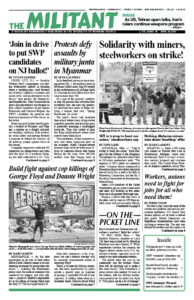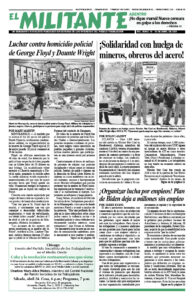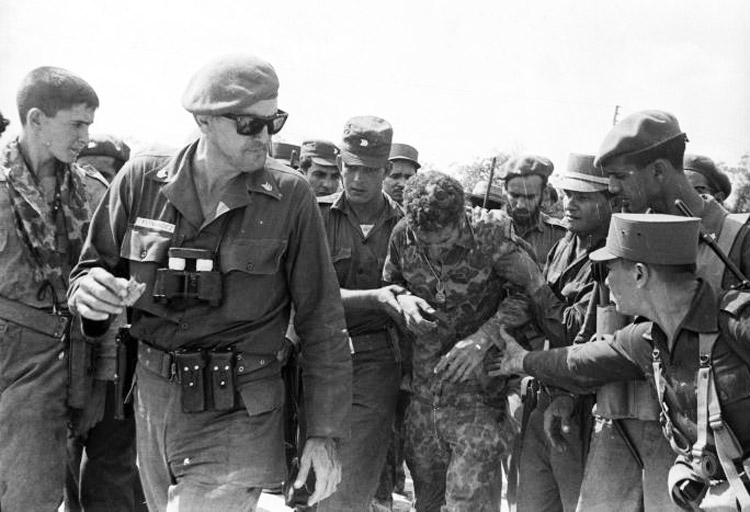This week’s special book feature is Playa Girón/Bay of Pigs: Washington’s First Military Defeat in the Americas by Fidel Castro and José Ramón Fernández, marking the 60th anniversary of this historic event. Fernández was one of a group of army officers who revolted against the U.S.-backed Batista police dictatorship in 1956. He was imprisoned alongside, and joined, members of Fidel Castro’s July 26 Movement. Under Castro, he was the commander of Cuban forces that defeated the U.S.-backed invasion in April 1961 in less than 72 hours. The excerpt is from his 1999 testimony, “The Cuban people, rifles in hand, were convinced of their cause.” Copyright © 2001 by Pathfinder Press. Reprinted by permission.
We cannot discuss Playa Girón and its meaning without going back to its roots and viewing it as the culmination of a stage of the U.S. effort to destroy the Cuban Revolution, a stage whose final outcome was the defeat of Brigade 2506 on the sands of Playa Girón.
Most striking and surprising is the magnitude of the CIA plan, with not a single detail overlooked, whether military, economic, or political. These include: efforts to prepare and trigger an insurgency in mountainous regions; efforts to destabilize and subvert the entire country including the use of terrorism; attempts to create a psychological climate conducive to the objective of destroying the Revolution; recruitment and training centers to ensure the optimal preparation of the mercenary brigade for conventional limited-range battles, including supplying it with technical resources, i.e., weapons and equipment of all types, including fighter planes and heavily armed ships; the assembling and structuring of these forces; the manipulative and deceptive — and, at the same time, domineering — role of U.S. military and political leaders in working with the members of these forces; and many other aspects.
The magnitude of these plans has been covered up by the enemies of the Revolution, who are more concerned with attributing the defeat to the mistakes and deficiencies of the U.S. administrations involved rather than finding the true causes of the debacle.
It is also necessary to mention here the measures taken by the Revolution, under Fidel’s leadership, to foil the enemy’s plans. To be noted are the actions against banditry and against infiltration by the CIA and by counterrevolutionary organizations operating both in Cuba and the United States; the fight against sabotage, which reduced to ashes some of the country’s most important retail and industrial establishments; the crushing of all the truly record number of attempts to assassinate the Commander in Chief in the period prior to Girón; Fidel’s success in clarifying the situation in face of the plans to intimidate the people through psychological means, using a whole arsenal of methods and propaganda techniques of subversive warfare; Radio Swan, the lies and the rumors — completely unethical, brazenly cynical, and malicious — such as those that promoted the campaign around child custody, which was designed to trample on the most cherished values of the Cuban family.
From a strategic and tactical point of view, the concept of the operation was not flawed. They chose an area where they could disembark, where there was an airstrip and buildings, and that was separated from solid ground by a swamp, across which there were only three roads, on which they were to drop paratroopers. …
What we have said about the adequacy of their choice for the zone of operations is valid. … This is corroborated by José Pérez San Román, leader of the mercenary brigade, in his book Respuesta: La verdad sobre Girón: “The goal of the Cuban mission was to assure this beachhead and establish itself on a portion of free Cuban territory on which to immediately bring in the broadly representative Cuban Exile Government, to convert it into a Cuban Government in Arms that would be granted international recognition … along with the accompanying political, economic, and military support already arranged by the U.S. government and a number of Latin American countries.”
The mercenaries came well organized, well armed, and well supported. What they lacked was a just cause to defend. That is why they did not fight with the same passion, courage, conviction, valor, firmness, bravery, and spirit of victory as did the revolutionary forces.
Hence the surprise at the scope of the Cuban people’s victory. This must have surprised the U.S. government, which expected a different result. The outcome can be explained only by the courage of a people who saw the January 1 triumph as the genuine opportunity to determine their own future. This is why they proudly wore the militia uniforms and were on alert, and willing to fight, with the firm conviction they would win.
The men and women, the people who in early January 1959 cheered Fidel Castro in his triumphant tour of nearly the entire island, were the same ones who on April 17, 1961 — convinced of their cause, rifles in hand, conscious of the declaration of the socialist character of our revolution — were determined to resist and repel the U.S. attack.
Over that brief period, the Revolution’s work, and Fidel’s words in particular, reached deeply into the hearts of the Cuban people, who identified with the ideas of national sovereignty, social justice, equality, and dignity. The Revolution had resolved the land question. It was taking sure, tangible steps to put an end to racial discrimination and the discrimination against women. It was assuring access by the masses to employment, education, health care, sports, and culture. The goal of eradicating all forms of corruption took hold in the collective consciousness, a concrete manifestation of the economic and social gains made in such a short period of time.
Fidel personally led the fight against the imperialist attack at Girón. This aggression was waged by the mercenary brigade and saboteurs, by bandits in the countryside and CIA agents, by reactionaries and traitors of all stripes who had sold themselves to the empire. In this fight, the Cuban people knew what they were defending, and they did so with a sense of patriotism and revolutionary fervor. Their firm support of the Revolution and Fidel was a decisive factor in the lightning-quick victory over the mercenary invasion.


